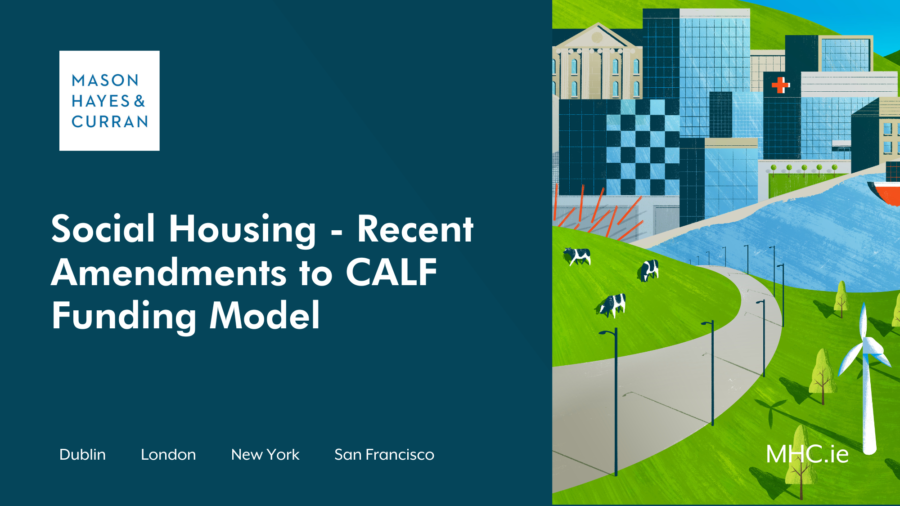
The Department of Housing, Local Government and Heritage (Department) has recommended amendments to the Capital Advance Leasing Facility (CALF) funding model. CALF funding, including Payment and Availability funding, is the main source of funding for Approved Housing Bodies (AHBs) for social housing delivery.
The Department’s aim is to address the challenges faced by AHBs in accessing funding to build social housing, particularly in rural towns and villages where local market rent is lower. It is also hoped that the revised model will assist with viability issues, caused by interest rates and construction inflation, for social housing projects in urban areas.
Recommendations were made following a review of the CALF funding structure (Review). This review was a specific commitment under Housing for All.
Recommendations following the Review
- The link between the Payment and Availability Agreement (P&A) amount and a percentage of local market rent should be discontinued
- A working group should be established to investigate the issue of gearing in the AHB sector
- The option of early repayment of the CALF loan should be explored
- The CALF loan should remain as a repayable loan and a guide should be issued regarding its repayment
- There should be an explicit link between applications for financial support under P&A/CALF and the Housing Delivery Action Plan of a Local Authority, and
- The definition of when a project is considered to have been delivered should be when the sale has taken place and the utility connections are in place.
Removing the link with local market rent
The recommendation that will have the greatest impact on the provision of social housing by AHBs is the de-linking of the P&A amount from local market rent. This recommendation was made as a result of analysis of multiple options explored by the Department as part of the Review.
Previously, AHBs have encountered difficulties with social housing projects in areas of low market rent as the P&A amount was insufficient to generate enough income to allow the AHB to borrow sufficient funds.
Breaking the link with local market rent will increase the P&A amount available. Accordingly, it will ensure the CALF funding model will work in all local authority areas as the P&A amount will now be established on a cost basis. While the tenancy will be registered with the Residential Tenancy Board, the level of P&A agreed is not published and will not influence the level of prevailing market rents.
The Department has identified several risks associated with removing the link to local market rent, including insufficient finance at the end of the P&A term. To address this concern the Department will implement a two-factor approach:
- The debt-service cover ratio (DSCR) should be set at a maximum of 1.2 to ensure cost control and oversight is maintained from a value-for-money perspective, and
- There will be a minimum of 25% CALF funding to prevent projects delivering on P&A funding alone
Gearing and repayment concerns
Of the other recommendations made under the Review, the primary ones that will be of note to the AHB sector relate to gearing and repayment concerns.
The Housing Alliance, a representative group comprised of a number of leading AHBs, expressed concern over the level of debt-financing AHBs must take on to fund social housing projects. Currently 100% debt financing is required. Under the Review, the Department considered advancing a CALF loan as a grant as one of the options. However, its analysis was that this would significantly increase costs to the State and would not increase the borrowing capacity of AHBs as such capacity is dictated by the income from the property. The Department has acknowledged that this is a serious issue of concern and has recommended that a working group be set up to consider the gearing issue in the wider context of AHB policy.
Following the publication of the Review, the Housing Alliance are calling for an element of grant funding to be incorporated. If such funding could be provided alongside the current reforms, rather than as a replacement of the CALF loan, that would certainly be welcomed.
Despite the Review and the views of certain stakeholders, a CALF loan will still be repayable for the foreseeable future. The Department acknowledged that there is a lack of specific operational procedures in relation to the repayment of CALF and that this has contributed to the overall impression that AHBs will not be called upon to repay the CALF loan. To tackle this, the Department recommended that written operational procedures are published which give specific guidance and instructions to AHBs on CALF loan repayment.
The Department also recommended consideration of how to restructure the funding arrangement to allow for the earlier repayment of the CALF loan. Not only would this allow the State to recycle its funding, it was also suggested by the Department that it would assist AHBs in tackling high gearing levels. This will require engagement with other stakeholders, such as the Housing Finance Agency and private lenders.
Conclusion
The revised funding model is welcomed by the sector and seeks to address financial viability issues of social housing projects in areas of low market rent. It should also help AHBs in addressing challenges arising from construction inflation and interest rate rises. However, continued engagement and further action will be required to fully address the concerns of AHBs regarding their funding structures.
For more information and expert advice on the CALF funding model, contact a member of our Financial Services team.
The content of this article is provided for information purposes only and does not constitute legal or other advice.
Share this:





